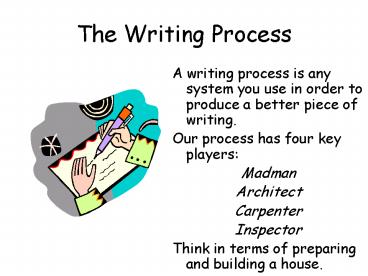The Writing Process - PowerPoint PPT Presentation
1 / 10
Title:
The Writing Process
Description:
The Writing Process A writing process is any system you use in order to produce a better piece of writing. Our process has four key players: Madman – PowerPoint PPT presentation
Number of Views:240
Avg rating:3.0/5.0
Title: The Writing Process
1
The Writing Process
- A writing process is any system you use in order
to produce a better piece of writing. - Our process has four key players
- Madman
- Architect
- Carpenter
- Inspector
- Think in terms of preparing and building a house.
2
Stage 1 MADMAN
- This is the idea man.
- He has all of these different ideas zooming
around in his head, and he just has to get them
all out on paper. - This is also called PREWRITING.
3
MADMAN ACTIVITIES
- Simple brainstorming
- Put your topic at the top of a blank sheet of
paper and write everything that comes to your
mind when thinking about your topic. - Listing
- Write your ideas and thoughts in a list or
column on the blank page. - Webbing or clustering
- Write your topic in the center and circle it.
Then as you think of things about your topic,
consider how they are related to each other and
place them on your paper with lines attaching
them to other related thoughts. - Freewriting
- Using sentences but not paragraphs, write down
any thoughts or ideas you have about your subject.
4
Stage 2 ARCHITECT
- This is the designer or planner.
- He has to try to look at all of the Madmans
ideas and organize them . His job is to come up
with a blueprint, design, or plan for the paper. - This is also called OUTLINING.
5
ARCHITECT ACTIVITIES
- Formal Outline
- Make a formal outline with headings and
subheadings. Make sure the outline sections are
parallel and indented properly. - General Divisions
- This is similar to a formal outline however, it
does not have the strict form of the formal
outline. For this type of plan, you simply
write down your major areas in your topic and a
few minor subsections or details. - Graphic Organizer
- Use one of the charts or diagrams we studied to
outline your topic. - Ordered Questions
- List in order any questions you have about your
topic that you would like to answer in your paper.
6
Stage 3 CARPENTER
- This is the actual builder. He uses the plans
that the architect designed, and he begins to
build by putting sentences and paragraphs
together. - This is also called DRAFTING.
7
CARPENTER ACTIVITIES
- Drafting
- This is the first attempt at writing your paper.
The carpenter gathers all of his tools
(prewriting, outlines, notes, dictionary,
resources, etc.) and begins to assemble the
paper. - He makes sure that he constantly checks the
architects plans, so he can keep the paper
organized and on track. - The carpenter needs to build the foundation
first, and he needs to ensure that each paragraph
has enough material to support the statements he
is making, just like a real carpenter must use
materials and structures that will support each
floor of the building he is constructing.
8
Stage 4 INSPECTOR
- This is the time when you go back through your
draft and look for anything that needs to be
changed, deleted, added, rearranged, or
corrected. - This is also called PROOFREADING.
9
INSPECTOR ACTIVITIES
- Proofreading
- Check for any misspelled words, incorrect
grammar, and punctuation mistakes. - Have someone reliable read your work and evaluate
it. - Check for organization and make sure every
sentence is relevant to the topic. - Make sure you have supported your ideas with
clear details or arguments.
10
FINAL WORDS
- Remember that the writing process is a cycle.
After the Inspector stage, you may have to go
back to the Carpenter stage again to fix problems
or rewrite sections. You may also have to go all
the way back to the Architect stage to redesign
part or all of your plan or reorganize it to make
more sense. - However, if you practice and use this process,
you will see improvement in your writing.































